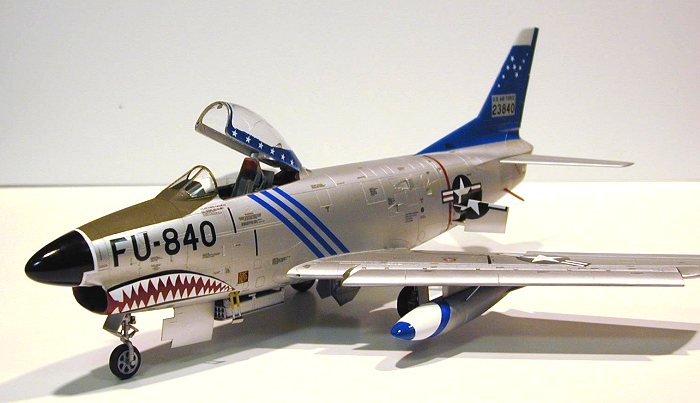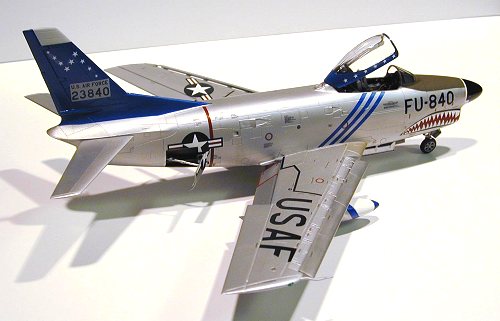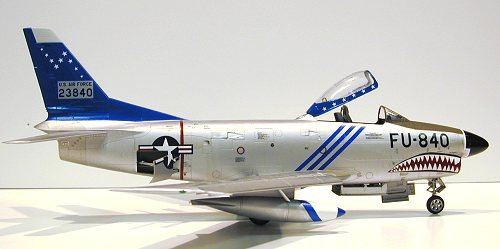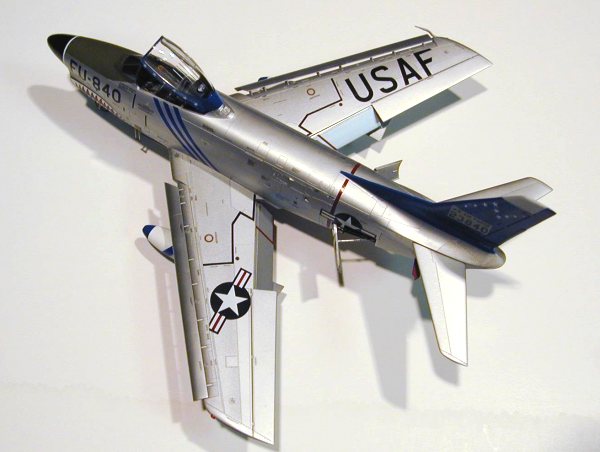
|
KIT # |
5960 |
|
PRICE: |
$22.65 |
|
DECALS: |
Two Aircraft |
|
REVIEW BY: |
Rick Wilkes |
|
NOTES: |
` |

|
THE KIT |
This is the ProModeler release of the F-86D " Dog Sabre" single seat interceptor. It comes in a "traditional" style box, i.e. a separate top and bottom with pictures of the assembled kit, and necessary supply list on the sides. Inside the box you will find four trees of ocean gray parts in two bags. To prevent the trees from rubbing against each other RM has engineered them with interlocking pegs on the corners with hold the trees apart, a very original solution. The clear parts are packed with the fuselage in such a way that they should not be scratched. The molding is exceptional and features finely recessed panel lines. There was no flash, obvious sink marks or injector pin marks, and the trademark data is on the under side of a flap, where it can be sanded off with out any loss of surrounding detail. As usual with RM the clear parts are crystal clear and thin and cast in such a way that the sprue gates are on the gluing surfaces. The kit also includes the tow tractor from the ground equipment set which comes in its own bag.
 The
16-page instruction manual features a short history of the F-86D, 12
construction steps for the aircraft, 1 step for the tow tractor, and
painting/decal instructions for two versions. It also has photos of the cockpit,
wheel wells, landing gear and the rocket tray from a preserved Sabre Dog.
The
16-page instruction manual features a short history of the F-86D, 12
construction steps for the aircraft, 1 step for the tow tractor, and
painting/decal instructions for two versions. It also has photos of the cockpit,
wheel wells, landing gear and the rocket tray from a preserved Sabre Dog.
All parts are named and paint call outs are by color from a list on the front page that shows all the colors called for with FS 595B number as appropriate. However, in steps 8 and 9, you are referred to the Decal Placement guide for painting instructions for the rocket tray and speed brakes. Unfortunately there is no specific mention of either of these assemblies there. The rocket tray is overall natural metal; the speed brakes are natural metal outside and silver paint on the interior. The speed brake wells are interior green. One note on the colors, I could not find Gloss Dark Blue FS 15095, in any of the current paint lines. The closet match off the rack was Testors French Blue No 2715 from the Model Master II line, which appears just a touch to light. I mixed my own using 2 parts Testors No 1110 Bright Blue and 1 part Testors No 1111 Dark Blue from the ľ oz bottles in the General Hobby Enamels line. This proved to be an excellent match for the blue of the fuselage and drop tank stripes decals provided for the 498th FIS aircraft.
Overall, I found the instructions to be well laid out and in a logical sequence, although I did deviate from the construction sequence in a several places and will cover those in the construction section.
|
CONSTRUCTION |
Construction begins with the cockpit, and RM has done a beautiful job. The side consoles feature raised detail for all the switches, buttons, and breakers, which will benefit from careful dry brushing. A separate throttle and radar antenna control are provided and add greatly to the overall effect. The instrument panel has 6 parts and bears careful assembly to insure good square joints. When assembled and painted you begin to understand why Sabre Dog pilots required more crew training than any aircraft in the inventory at the time. The completed cockpit and nose gear sidewalls are attached to the intake trunk. The intake trunk is split laterally and the seams cleaned up easily with sandpaper wrapped around a cuticle (orange) stick. I left the nose gear assembly off during stage 1c and had no trouble adding it during final assembly. The tail pipe assembly is neatly done and has no seams for "prying eyes" to find later.
Moving to the fuselage, the scoops were added which press fit, then touch of liquid cement and they were finished, beautiful fit inside and out. All the previous sub assemblies were added to the right side then the fuselage halves were joined. I used super glue and need only a light sanding and polishing to have paint ready seams. Two things to note, in step 3a youíre asked to open 3 holes in the bottom of the fuselage centerline. The forward two are for the rocket tray and the aft one is for a clear peg to keep the kit from tail sitting. If you donít intend showing the rocket tray deployed, and/or plan to use weight inside the nose to balance the kit on its gear, donít open these up. I also left out the landing light lens and replaced it with Micro Krystal Kleer after painting. The Radome/intake is added at this time. It joins the fuselage on a panel line and makes a neat joint with the intake trunk, very nicely engineered. I used 12-14 grams of lead shot in the radome and plane sits firmly on it nose wheel.
 The
wing assembly included the main gear wells; make sure you get a good joint at
the rear of the wing in the flap well. I had problems with this joint opening up
repeatedly and I think that the top of the wheel well was interfering with the
underside of the top of the wing. Donít know if it was the kit or me, but be on
the look out there. The wing fits very snugly with the fuselage sides being
trapped between the tops of the gear well and the upper wing. I used a thin bead
of Mr. Surfacer 1000 painted into this joint then cleaned off the excess with
FlashBack Brand DeBonder. That was the only "filler" used anywhere on the kit,
that was probably unnecessary. At this point I painted the model and added the
decals. The rest of the assembly is straight forward, and consists of the
"fiddly bits" that rapidly limit the places you can pick up the kit. Take your
time and make sure your mating surfaces are free of paint and youíll have no
problems.
The
wing assembly included the main gear wells; make sure you get a good joint at
the rear of the wing in the flap well. I had problems with this joint opening up
repeatedly and I think that the top of the wheel well was interfering with the
underside of the top of the wing. Donít know if it was the kit or me, but be on
the look out there. The wing fits very snugly with the fuselage sides being
trapped between the tops of the gear well and the upper wing. I used a thin bead
of Mr. Surfacer 1000 painted into this joint then cleaned off the excess with
FlashBack Brand DeBonder. That was the only "filler" used anywhere on the kit,
that was probably unnecessary. At this point I painted the model and added the
decals. The rest of the assembly is straight forward, and consists of the
"fiddly bits" that rapidly limit the places you can pick up the kit. Take your
time and make sure your mating surfaces are free of paint and youíll have no
problems.
All joints are on panel lines and the fit through out is excellent. For my money this is the best-engineered kit I have ever built, especially important when the main color scheme is natural metal.
Accuracy:
Sorry I donít do accuracy checks other than to see if the finished product looks like what it purports to be. I have seen various "problems" reported on the web but boys and girls this kit passes muster big time on the "looks like one to me test". One note I did see that is worth mentioning is the trim tab on the rudder. It is correct for FU-863 "Dennis the Menace" which was modified for stability tests, but needs to be trimmed and shortened for other aircraft. Thee Decal Placement drawings show the standard configuration.
|
PAINT & DECALS |
Two schemes are provided both for F-86D-40ís, both without the para-brake.
The first is for FU-863, "Dennis the Menace" of the 97th FIS, ADC and for
FU-840 of the 498th FIS from Geiger Field, WA.
 I
choose FU-840, Iím sure the sharkmouth and the four-page gatefold in "Wings of
Fame" had nothing to do with my choice. As I stated earlier I used my own
mixture for the dark blue, and the masking on the drop tanks got tricky, but
itís a striking scheme when its finished. I used Krylon Shortcuts aluminum paint
for the base natural metal, Testors aluminum for the anodized sections on the
wings and fuselage and Testors steel on the "hot" section around the tail pipe.
I
choose FU-840, Iím sure the sharkmouth and the four-page gatefold in "Wings of
Fame" had nothing to do with my choice. As I stated earlier I used my own
mixture for the dark blue, and the masking on the drop tanks got tricky, but
itís a striking scheme when its finished. I used Krylon Shortcuts aluminum paint
for the base natural metal, Testors aluminum for the anodized sections on the
wings and fuselage and Testors steel on the "hot" section around the tail pipe.
The decals are perhaps the finest decals I have ever used out of a production kit. They are thin, in register, and settle down into every panel line using Mirco Set/Sol. That makes the fact that the red is totally wrong so frustrating. Testors British Crimson with a gloss coat matches what is supposed to be insignia red on the decals. Please RM get this fixed ASAP. The sheet includes an extensive maintenance stencil set and they are as good as any aftermarket set Iíve seen. Under magnification you can read all of them. The application sequence is logical and goes quickly since the decals are laid out in sequence on the sheet. Even so plan on at least two sessions to get then all on.
|
CONCLUSIONS |
Youíve figured out by now that I really like this kit, so much that Iíve purchased 2 more already. Take your time and it goes together quickly and easily, and with all the different choices for applying natural metal finishes, there no reason you canít turn these out "like so many rolls" to sort of quote some other guy. Highly Recommended. Now if we could get a Fury or a Banshee, Please.......
|
REFERENCES |
Wings of Fame, Squadron F-86 in Action, Squadron F-86 in Fighting Color
F-86D/K/L by Steve Ginter

Iíd like to thank Bill Lastovich of Revell-Monogram (RM) for donating this kit for review. The finished model may be seen at Metzlerís Hobby Center, 7418 Madison Ave, Indianapolis Indiana.
If you would like your product reviewed fairly and fairly quickly, please contact the editor or see other details in the Note to Contributors.